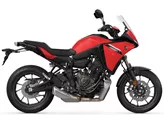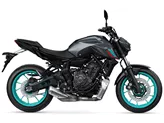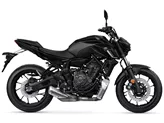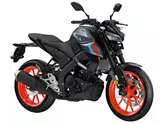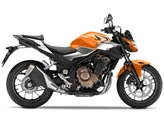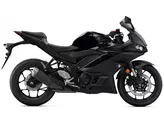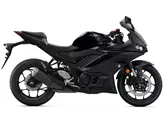Yamaha MT-07 2018 vs. Yamaha YZF-R3 2019

Yamaha MT-07 2018

Yamaha YZF-R3 2019
Pregled - Yamaha MT-07 2018 vs Yamaha YZF-R3 2019
The Yamaha MT-07 2018 and the Yamaha YZF-R3 2019 are both popular models from Yamaha, each with its own unique features and strengths.
Starting with the Yamaha MT-07 2018, it boasts an engine with a bore of 80 mm and a stroke of 68.6 mm, resulting in a powerful engine power of 75 HP and a torque of 68 Nm. With a compression ratio of 11.5, this bike offers excellent performance. The bike is equipped with a liquid cooling system, ensuring optimal engine temperature. The 689ccm displacement and the DOHC valve system with 4 valves per cylinder contribute to the bike's overall power and efficiency.
In terms of suspension, the Yamaha MT-07 2018 features a telescopic fork at the front, providing a smooth and comfortable ride. The front brakes consist of double disks, offering powerful and reliable braking performance. The bike has a front tire width of 120 mm and a diameter of 17 inches, while the rear tire has a width of 180 mm and the same diameter. The wheelbase measures 1400 mm, providing stability and control. The seat height is 805 mm, offering a comfortable riding position for most riders. With a kerb weight of 182 kg (with ABS) and a fuel tank capacity of 14 liters, the bike strikes a good balance between agility and practicality.

Yamaha MT-07 2018
The Yamaha YZF-R3 2019, on the other hand, has a smaller engine with a bore of 68 mm and a stroke of 44.1 mm. This results in a slightly lower engine power of 42 HP and a torque of 29.6 Nm. The compression ratio is 11.2, ensuring good performance. Like the MT-07, the YZF-R3 is equipped with a liquid cooling system for optimal engine temperature. The bike has a displacement of 321ccm and features the same DOHC valve system with 4 valves per cylinder.
In terms of suspension, the YZF-R3 2019 features an upside-down telescopic fork at the front, providing stable and precise handling. The front brake consists of a single disk, offering reliable braking performance. The front tire has a width of 110 mm and a diameter of 17 inches, while the rear tire has a width of 140 mm and the same diameter. The wheelbase measures 1380 mm, slightly shorter than the MT-07, but still providing good stability. The seat height is 780 mm, offering a slightly lower riding position compared to the MT-07. With a kerb weight of 169 kg (with ABS) and a fuel tank capacity of 14 liters, the YZF-R3 strikes a good balance between agility and practicality, making it suitable for both everyday use and racetrack conversions.
When comparing the strengths of the two bikes, the Yamaha MT-07 2018 stands out for its extremely agile engine, light handling, low weight, and aggressively angular look. It also boasts powerful brakes and a comfortable seating position. Additionally, the bike has a throaty sound, adding to its overall appeal.
On the other hand, the Yamaha YZF-R3 2019 is known for its high-revving engine, which provides sufficient power for everyday use and compact racetracks. It also serves as a good basis for racetrack conversions. The bike offers stable handling and is suitable for long distances, making it a versatile option for riders.

Yamaha YZF-R3 2019
However, both bikes have their weaknesses. The Yamaha MT-07 2018 has a chassis that is a little soft, and the footrests tend to drag quickly. Some cheap plastic parts can also be found on the bike, and the telescopic fork is considered boring by some riders. Additionally, the instruments could be easier to read.
The Yamaha YZF-R3 2019, on the other hand, has been criticized for its poor throttle response at low revs and the lack of feedback in the brake lever. Some riders may also find the knee angle too acute for their liking.
In conclusion, the Yamaha MT-07 2018 and the Yamaha YZF-R3 2019 are both impressive models from Yamaha, each with its own set of strengths and weaknesses. The MT-07 offers a more powerful engine and aggressive styling, while the YZF-R3 provides a high-revving engine and versatility for both everyday use and racetrack conversions. Ultimately, the choice between the two will depend on the rider's preferences and intended use of the bike.
Tehnične specifikacije Yamaha MT-07 2018 v primerjavi z Yamaha YZF-R3 2019
Primerjava prednosti in slabosti
Primerjava prednosti in slabosti
Yamaha MT-07 2018

The MT-07 is an incredible fun machine that is extremely sporty to ride. The brakes pack a punch, the handling is superb and the engine is currently by far the most agile power unit in this class - and even above. The light handling fits in perfectly and the aggressive design with its many corners and edges is also appealing. Only the chassis makes the typically good compromise between comfort and sport and should probably remind you that the affordable MT-07 also has a lot to offer beginners.
Yamaha YZF-R3 2019

Z novim YZF-R3 je Yamaha izkoristila zelo dobro osnovo prve generacije in jo uspešno nadgradila. Zdaj se zdi ne le vizualno zrelejši, temveč tudi opazno bolj kompetenten pri visokih hitrostih. Ko se z modelom R3 peljete na meji, hitro začutite, zakaj je Yamaha nanj postavila svoj pokal, saj že standardni model zagotavlja varen občutek pri visokih hitrostih. Kljub temu je še veliko prostora za izboljšave, zlasti pri vsakodnevni uporabi, ko groba odzivnost pri nizkih vrtljajih in slaba povratna informacija z zavorne ročice povzročita nekaj trenutkov razočaranja med vožnjo.
Primerjava povprečnih tržnih cen Yamaha MT-07 vs Yamaha YZF-R3
There are a few key differences between a Yamaha MT-07 2018 and a Yamaha YZF-R3 2019. In terms of price, the actual average price of a Yamaha MT-07 2018 is about 23% higher. Compared to Yamaha YZF-R3 2019 there are more Yamaha MT-07 2018 bikes available on the 1000PS.de Marketplace, specifically 28 compared to 4. It takes less time to sell a Yamaha MT-07 with 54 days compared to 99 days for a Yamaha YZF-R3. Since model year 2013 1000PS.de editors have written 69 reviews for the Yamaha MT-07 and 11 reviews for the Yamaha YZF-R3 since model year 2015. The first review for the Yamaha MT-07 was published on 11/4/2013 and now has more than 12,600 views. This compares to more than 53,600 views for the first review on Yamaha YZF-R3 published on 10/17/2014.


